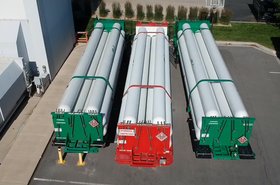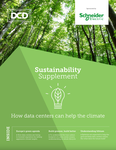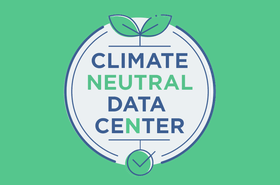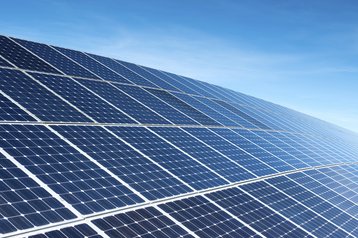When EU vice president Frans Timmermans set out the bloc’s Green Deal at the end of 2019, he proposed that central government support and digitization could help all sectors of society go carbon-neutral by the end of 2050, making Europe the first climate neutral continent.
At that time, the US was effectively a climate-change denier, outside the Paris Climate agreement.
Just over a year later, things have changed. Europe’s commitment remains strong, while a new administration has brought the US back to the table. President Biden has reinstated the Obama administration's green agenda, and promised to reach carbon neutrality by 2050.
Change coming in the US
Even before the end of the Trump administration, a bipartisan bill was passed, which showed signs of change. The huge Consolidated Appropriations Act, weighing in at more than 5,500 pages, included an Energy Act, which itself contained two sections, calling for more efficient data centers.
The act calls for an update to a 2016 study into data center energy use from Lawrence Berkeley National Laboratory, which must be produced within four years. It also demands an examination of the energy impact of cloud computing, and requests a new metric for data center energy use.
2020 also saw the Covid-19 pandemic, of course, a global event which will cause a re-evaluation of data centers and energy. Lockdowns cut emissions temporarily, and pushed society further down the digital route, with cloud services enabling people to remain home where possible, to minimize infections.
Coming out of lockdown, those same tools will be integral to making businesses run more efficiently, to cut emissions. It seems that, if we are to reach Net Zero, data centers will have to lead the way.
Given the US is only starting to look at how to enable this, let’s look at developments in Europe.
Europe's ambition
Early in 2021, Europe’s data center providers responded to the Green Deal with a commitment to beat the European target and be climate neutral by 2030. It was the result of negotiation behind the scenes which began after Timmermans’ announcement.
At a DCD online event in February, Towards Net-Zero (available on demand), the data center leaders behind the Climate Neutral Data Center Pact explained how it happened. Both the European Data Center Association (EUDCA), and CISPE (Cloud Infrastructure Services Providers in Europe), independently went to talk about climate change with the EU authorities.
“We met with leaders of CISPE, and it turned out they were going the same direction as us,” said Michael Winterson, managing director services for Equinix, and a board member of EUDCA. The two groups agreed to a challenging set of targets, “so we could meet the EU with a positive message.”
“We wanted to create a story together and ensure that we had metrics which could be met by every player in data center industry and the cloud services industry,” added Alban Schmutz, chairman of CISPE and SVP public affairs at Europe’s largest cloud provider, OVHcloud. As well as EUDCA and CISPE, the talks pulled in more than other 20 trade associations, including national data center groups.
The data center crowd got a good reception from the EU, partly because they were ready to commit to any targets at all, said Winterson: "As far as I can see we are the only industry in Europe that is accepting to targets. Every other industry is pushing back, saying 'we want more time,' or saying it is not possible. But we are meeting the targets. That's a bold step."
Both men are clear that they want this approach, because if they didn’t voluntarily propose their own moves, the EU would eventually impose its own demands on them. The data center sector has a fear of regulations imposed from outside, which might end up mandating specific technologies.
Fear of regulation?
It's easy to overstate the threat - and fear - of regulations. "It’s not that we don’t want to be regulated," Winterson said, pointing out that most data center operators are actually pretty keen on regulations: "Most subscribe to ISO, TUV, and BSI standards. We have to deal with city-based and state-based regulations, and see that staff are trained to work in high voltage environments."
Winterson puts it more positively, arguing that regulations would cost money to create and police: "It would be very expensive for the EU to set up a regulatory environment, and set up an agency to administer it," said Winterson. "We have saved them from that huge financial burden."
In any case, regulators potentially have a more basic understanding of the tech, so their proposals will not be as good as the sector’s own ideas: “If we don't do this it will lead to regulation, which will be less effective than if we do something today.”
Schmutz says that, with data centers toeing a self-created line, regulators can spend their time elsewhere: “The people who would be working on regulation for this topic may go and work on another topic."
Having got the ear of the European Commission, Winterson, Schmutz, and colleagues had to come up with a program of targets that their members could accept. That was a tough ask, because EUDCA and CISPE and other bodies include a broad range of members, from giant cloud providers running monolithic applications in new data centers built to high-efficiency specifications, as well as smaller operators having to serve multiple customers inside older facilities
It's easier if your big?
Big cloud providers have a clear benefit here: they can set their own targets, and upgrade hardware at will. Hosting the virtual data centers of many customers in their facilities, they get the efficiency benefits of sharing resources between those customers, an effect which is already credited with enabling a massive increase in world compute power for a minimal increase in energy use.
But smaller players will sign up, says Apostolos Kakkos. He’s chairman of the EUDCA board and CEO of Lamda Hellix, a 6MW provider in Greece (which is now in the process of being absorbed by Interxion, part of data center giant Digital Realty).
“I don’t agree that you can’t be green if you are small,” Kakkos told DCD. “There‘s no conflict between being green and cost efficient, and making more money. If we are green, we consume less energy, so we are either more competitive or we make more money - or both!”
The specific goals of the Climate Neutral Pact are within the reach of small colocation players. Kakkos says Lamda Hellix met the PUE target years ago and is carbon neutral on paper, through renewable energy certificates (RECs). Taking in the other targets, he says: “We’ll be 75 percent climate neutral by 2025, and net zero by 2030.”
If it’s that easy, then was the bar set too low? Schmutz disagrees: “This is ambitious, but achievable. We can argue if the metric could be lower or higher. It is already a huge jump if we take the average across Europe. We agreed the target with the European Commission.”
The pact was never going to be a heavy-handed drive to push customers onto the large cloud platforms which have resources to meet green targets, said Winterson: "We specifically called out this issue. There is a fundamental issue here: a big provider like Equinix can raise a green bond; Global Switch recently raised one for $750 million. Smaller data centers can’t have access to that funding."
Happily, the EU has a long-standing commitment to support smaller enterprises (SMEs), which make up the bulk of any market. The Pact members expect support from the EU’s sustainability fund for smaller providers to implement improvements.
"We will be pushing for that to be part of the Green Deal funding,” said Winterson.
Supporting EU business
“The overall interest in the EU is to have a vibrant ecosystem, which can include the smallest players with added value. We needed to have this ecosystem working," said Schmutz, most of whose members are SMEs: “What we do with this pact is not asking everyone to be best in class on everything. We are not creating burdens for SMEs."
The other interest of the EU is to make sure any measures don’t price local providers out of the market. Under the pact, Winterson says “EU SMEs can offer services to compete on a level playing field against international - read US and Chinese - vendors."
Kakkos thinks the Pact will become table stakes for any government deals: “We believe in a couple of years, people who have signed up to the pact will be commanding the market. It will not be easy for other people to be in the market if they are not in the pact. Clients will be asking for it, and vendors will be chosen because they are in the pact.”
It may sound awkward against a goal of reaching net-zero, but Winterson sees a business opportunity in the Pact:
“The people who’ve signed are predominantly cloud and colocation providers, but we’re fielding requests from telecoms companies, and my feeling is eventually enterprises and governments will join.”
These organizations will work out whether they can build their own data centers efficiently, and Winterson thinks more will outsource: “We know how to use technology to beat the targets. They need to decide whether to use the tech to retrofit, or to end of life that facility and move to cloud and colocation in ten years.”
“Enterprises and governments are realizing it makes more sense to not build data centers for in-house use, compared with doing it in an information hub. It makes a lot of sense for them to outsource, not just for economic reasons, but also for sustainability and green reasons.”
Lessons for other sectors
Winterson thinks the Pact will be a template for other industries: "We can be the catalyst that tests new ideas for the benefit of other industries, like transport and mining."
And Schmutz thinks it could be applied in other nations: "Europe is not unique. It is a collection of various states. What we have done is a laboratory of what can be done at an international scale, not only in Europe. If we can succeed in Europe it can have effects in other places," he said, pointing out that other European initiatives such as GDPR for privacy, have been used or partially adopted elsewhere.
But while Winterson, Schmutz and Kakkos believe they have evaded legislation, and have held their members’ feet to the fire to create real commitments, others aren’t so sure.
One skeptic DCD spoke to is Ed Ansett, chairman of consultancy i3 Solutions Group. “At the moment I’m struggling with any data center anywhere being carbon neutral by 2030,” he said. “What they mean is near zero perhaps.”
While efficiency measures like PUE ensure that less power is wasted on the way to the IT kit, there is nothing to ensure that compute cycles are used effectively. Data center operators face an economic incentive to sell more services, and little incentive to make sure those services are used efficiently, so cloud providers will sell customers resources they don’t need.
With those drivers in place, Ansett thinks data center operators can’t be left to mark their own homework.
“An effort like this is laudable, but if we are going to do something we cannot leave it to goodwill,” said Ansett. “A lot of the things you’ve got to do are going to be costly and involve compromise. If we’re going to do something, in my opinion it requires a mandate. You can’t do it yourself. It requires regulation from above.”
Time will tell who is right.
More from DCD
-

Broadcast DCD>Grid Scale | Stream on-demand
-

-




